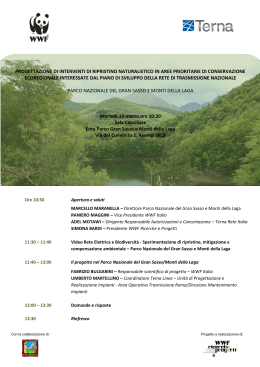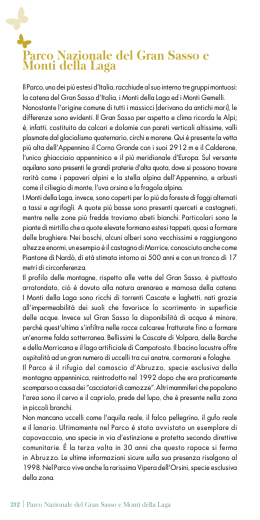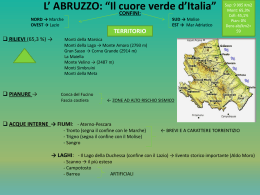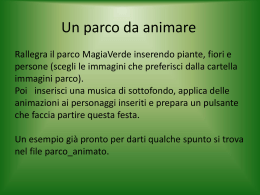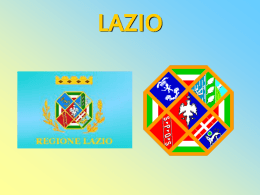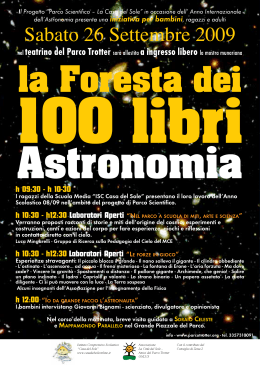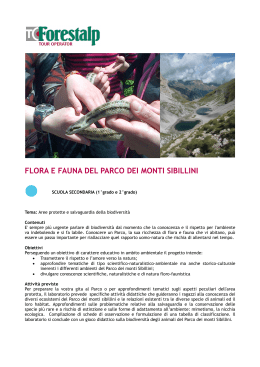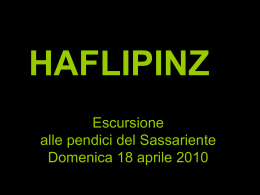OPERATING MANUALE FOR PREDATOR DAMAGE ASSESSMENT ON LIVESTOCK (Elaborated under the LIFE07/NAT/IT/000502 project “Improving the conditions for large carnivore conservation – a transfer of best practices”- EXTRA) Edited by: dr. Umberto Di Nicola1 With the collaboration of: dr. Simone Angelucci2 dr. Daria Di Sabatino3 dr. Marco Innocenti3 1Veterinary Doctor 2 3 Gran Sasso e Monti della Laga National Park Veterinary Doctor Majella National Park Veterinary Doctor freelance Vers. 01 April 2010 “ Manuale Operativo per l’accertamento dei danni al bestiame da predatori” Form 1 - Front 1. Introduction Conflict situations in the zoo-technical world are generated in areas used for breeding and grazing and which are at the same time inhabited by wild species such as wolves and bears. The rules in regards are very heterogeneous, not only from Country to Country but also on the responsibility basis of territorial entities. The main system used for managing conflicts deriving from livestock predation is compensation based on a critical damage assessment, accompanied by a forensic expertise and finalized in detecting and collecting data in a standardized way useful for comparison and use at managerial level. 2. Livestock damage assessment inspection The inspection is part of the procedure carried out by competent and responsible institutions following a complaint for presumed predation on livestock and is necessary for observing and documenting what happened to the carcass in question. The aim of the inspection is to assess and document what has happened. Authorized staff carries out the inspection, examining the carcass and the surrounding area. Difficulties and risks related to the inspection: Difficulty in reaching the carcass given to the absence of adequate and comfortable space necessary for the post-mortem assessment together with the difficulty in manipulating cutting tools; Biological risk related to the living animal (for the presence of parasites, agents of zoonoses, dispersion of organic liquids in animals carriers of infections, etc.) and to the carcass and its state of transformation (dipteral and other insect scavengers, which could act as carriers and stingers, polymicrobial flora related to putrefactive phenomena, etc.). Knowledge of the territory’s health history and a correct assessment of anamnesis reduce and limit the biological risk. The assessments/decisions will be left to the competent National Health Service’s Veterinary in case of doubt. Parco Nazionale del Gran Sasso e Monti della Laga “ Manuale Operativo per l’accertamento dei danni al bestiame da predatori” Parco Nazionale del Gran Sasso e Monti della Laga “ Manuale Operativo per l’accertamento dei danni al bestiame da predatori” Form 1 – Back 3. Assessment Anamnesis. It’s necessary to gather up as much information as possible from people who know what happened and from those who have made out the claim. It’s important not to neglect anything which has been said but at the same time it’s necessary to not be conditioned by it. General inspection of the environment. It’s necessary to gather information regarding the environment surrounding the carcass in order to direct subsequent investigations. Clues may be given by the battleground, footprints, dragging signs or eventual blood stains, the presence of cliffs, watercourses, etc. Identification of the carcass. It’s necessary to tag the carcass in order to carry out a photographical documentation of the assessment. The tag represents the link between the photographs and the carcass. Date: _________________ Breeder: _______________________________ Locality: ________________________________ Specie: ___________________ ID: __________ Ear tag number: _________________________ Investigating Officer: ______________________ External examination of the carcass. A general external examination of the carcass is effected, specifically the tegumentary apparatus, the muscular-skeletal apparatus, genital apparatus, external orifices relative to the digestive and respiratory apparatuses as well as the sense-organs which can be inspected. The first phase of investigation approximately estimates the PMI and evidences, through a first careful observation, any irregularities. Flaying of the carcass. Flaying the animal permits to gather information regarding environmental contact and distinguishes, already at this level, intra-vital wounds from postmortal wounds. Parco Nazionale del Gran Sasso e Monti della Laga “ Manuale Operativo per l’accertamento dei danni al bestiame da predatori” Internal examination of the carcass. The muscular-skeletal apparatus and the internal cavities (thorax/abdomen) are examined, then the serous and the organs which they contain. Parco Nazionale del Gran Sasso e Monti della Laga “ Manuale Operativo per l’accertamento dei danni al bestiame da predatori” Form 2 - Front Detailed investigation of the environment. A search for elements of comparison and confirmation to the diagnosis formulated is effected, and in case of incongruity a search for elements for an eventual reexamination of the case. 4. Predation PREDATION is the process in which an animal spends a certain quantity of energy to find a living prey, and further energy to wound or kill it (E. Curio). The intra-vital wounds are the anatomic-pathologic result of all the interactions between the predator, its prey and the surrounding environment. • The predator Wolf / Bear / Lynx / Fox Dog Each specie uses different predatory techniques related to its physical characteristics. The victim’s wounds are always different because each predator has a different way of hunting down its prey. • The prey Deer / Boar / Roe-buck Cattle / Sheep / Equine Each wild specie has and uses different anti-predator mechanisms, related to its physical characteristics. Domestic animals are considerably easier to hunt because they have lost a large part of these mechanisms through selection. The action of the predator on the prey produces direct wounds. The environment Woods / Open pastures / Pastures with bushes or trees The predator’s attacking technique and the prey’s defensive mechanisms are both influenced by environmental characteristics such as covered areas (where the predator can hide), impervious surfaces and obstacles of various nature. Preys can suffer from indirect wounds caused by a particular environmental context. Parco Nazionale del Gran Sasso e Monti della Laga “ Manuale Operativo per l’accertamento dei danni al bestiame da predatori” Parco Nazionale del Gran Sasso e Monti della Laga “ Manuale Operativo per l’accertamento dei danni al bestiame da predatori” Form 2 - Back 5. The assessment of the predation event A preliminary action of fundamental importance during the inspection is collecting information from people acknowledging the facts. Each piece of information must be noted down and evaluated but must not influence the search of details in the forensic expertise. The carcass must be identified by filling out the identification tag. Firstly, it’s photographed alone, then within the surrounding environment and finally photographs of specific details and of the singular anatomic regions are taken (ex. head, thorax, abdomen, limbs). The photographic reportage is followed by the examination of the environment surrounding the carcass in search of signs and elements related to it, taking note of them and photographing them (ex. traces of blood, organic material, footprints, excrements). Hairs, excrements and tracks of a predator only represent signs of its presence in the area but in no way connect him to the predation event. Not even the proved consumption of a carcass can tie a predator to its killing, but it’s only the expression of a scavenger behavior common to nearly all predators, especially in the first years of life. After wearing the necessary protective devices, the carcass can be examined externally in an accurate and standard way, proceeding from the head towards the tail in order to eventually come across: • Skin interruptions: they must be thoroughly and individually examined, distinguishing the intra-vital from the post-mortal ones, and establish how they were produced. o A wound suffered in life brings about a reaction characterized by an inflammatory state. It will be possible to notice an increase in the diameter of the capillaries around the injury, an inflammatory edema and a hemorrhagic infarction. There will be no reaction of the tissues in an injury suffered after death. o Bites produce a lacerated and contused wound given to a compression and traction action practiced by the mouth and the head of the predator through its teeth. The canine has a conic shape (curved, with a convex medial margin and a concave distal margin) with an ovular section with rounded margins and with a simple rounded-point extremity. Parco Nazionale del Gran Sasso e Monti della Laga “ Manuale Operativo per l’accertamento dei danni al bestiame da predatori” Form 3 - Front 5. The assessment of a predation event When it penetrates the skin it produces a wound having an ovular form with frayed margins and rounded borders. Slash wounds are caused by tools with pointed tips, while wounds caused by cutting tools are the results of the action of the object’s fine, sharp and linear edge. A cutting weapon produces wounds with an oblong shape with net margins and acute extremities. • fractures: the surrounding muscles and the periosteum are observed to highlight bruises and blood spilling in order to establish if they were produced in life or after death. The cause of the fracture (bite, impact, etc.) may be evidenced through the examination of the margins and of the surrounding structures. Species with a thick fur must be shaved in order to permit an easier and more accurate analysis and documentation of eventual external wounds. The external examination of the carcass is followed by a subcutaneous and muscular examination. This phase requires the flaying of the carcass, an operation which must be carried out respecting professional competences, regulations regarding veterinary laws and job security. The flaying evidences the following: o Intra-vital and post-mortal wounds. o Wounds from bites and cuts. The muscular tissue has minor elasticity compared to the skin, consequently, bites conserve an ovular form with frayed margins and rounded edges but present a more irregular aspect with regards to the corresponding coetaneous wound. The wound may present extroversion of the tissues from the edges because of the curved form of the canine and as a consequence of the retraction of the tooth. Wounds from cuts present a lengthened form, with net margins, acute extremities and net and regular edges of the walls. o Fractures and other organ and tissue wounds. o Systemic reactions. The investigation cannot be repeated therefore everything must be widely documented. Parco Nazionale del Gran Sasso e Monti della Laga “ Manuale Operativo per l’accertamento dei danni al bestiame da predatori” Form 3 - Back 6. Data collection form Everything that the carcass encountered during the period prior to its death must be evidenced through the investigation: the way it interacted with the environment, with the probable predator or the cause (trauma, infective pathologies or not, etc.) which determined it. A standard form facilitates the objective collection of the data and allows to gather the same information for every investigation so comparisons can be made. The subdivision of the data collection forms in sectors allows a logical flow in the assessment procedure and the subdivision of the data in categories. Identification of the damaged person. Example: name of the breeder, species raised (specie, races and number), working dogs (type, race and number), place and type of pasture, type of night shelter. Identification of the inspection. Example: date, hour of the inspection, animals involved (specie and number), dead animals, wounded animals, lost animals, adult animals (sex and age), young animals (sex and age), date of finding, date of claim, post mortem interval of each carcass, place where each carcass was found (place name and type) co-ordinates of finding, specific information referred by the breeder or by testimonies. Environment identification. Example: presence of traces, blood, tracks, excrements, fur. Examination of the carcass. Example: specie, race, identification of the carcass (tag number, ear tag number), skin examination, subcutaneous examination, examination of the muscular-skeletal apparatus, examination of the internal cavities, estimated weight, estimated consumption percentage (ex. head 10%, thorax 20%, abdomen 20%, left front limb 10%, right front limb 10%, left back limb 10%, right back limb 10%). Conclusions. Example: if the event has been caused by a predation or by something else; if there will be a refund or not; place and date; investigator’s name, surname and signature. Parco Nazionale del Gran Sasso e Monti della Laga “ Manuale Operativo per l’accertamento dei danni al bestiame da predatori” Form 4 - Front 7. Predation by wolves The wolf (Canis lupus - L.1758) is a predator mammal, it’s part of the canids family and represents its largest specie. It’s the wild ancestor of the dog. The dimensions of the body vary depending on the geographical area and on the subspecie considered. Even the colour of the fur, generally mimetic, is greatly variable and tends to lighter tones in the northern populations. The skull appears flat and broad, with the superior profile of the muzzle typically flat and lacking the so called “stop" The set of teeth is composed of 42 teeth. The carnassials or ferine tooth is particularly developed and preserves the function of cutting bones and tendons. PERMANENT DENTAL FORMULA (ADULT) M Pm C I C Pm M 2 4 1 6 1 4 2 3 4 1 6 1 4 3 The wolf is a generalist and an opportunist carnivore with a highly variable diet but strongly specialized in predation. Parco Nazionale del Gran Sasso e Monti della Laga “ Manuale Operativo per l’accertamento dei danni al bestiame da predatori” It’s a highly adaptable predator and takes advantage of the predation on domestic animals which have lost the capability of defending themselves during the process of domestication and therefore represent an alluring and easy prey compared to wild prey. Parco Nazionale del Gran Sasso e Monti della Laga “ Manuale Operativo per l’accertamento dei danni al bestiame da predatori” Form 4 - Back The wolf has developed the capability of choosing and hunting down its prey, attacking it with great ability in anatomic zones, in which, its powerful bite, reveals an elevated functionality which can be seen in the wounds on the carcass. 8. Predation by wolves Sheep and goat. In middle size preys such as sheep and goats, with a variable weight from 40 to 80 kg, the size of the animal and its height from the ground, as also the diameter of its neck and the thickness of its skin, permit the bite in a vital area which results to be extremely functional as can be evidenced by the wounds on the carcass. Predation Method: one or more localized bites in the upper part of the neck, right behind the mandible in the parotid region. In case of large rams, we can notice more bites in the target area as a consequence of the difficulty (given to the bigger dimensions) in biting and seizing the prey. The bite in this region, wounds and stimulates the carotid baroreceptors (present in the carotid forking point) and wounds and stimulates the vagus nerve. The stimulation of the carotid baroreceptors causes vasodilatation and cardio inhibition with hypotension, bradycardia and decrease of the cardiac output, while the vagal stimulation causes bradycardia. The assessment: Lacerated contused wounds from bites on the subcutaneous and on the muscles near the neck with vast ecchymosis and blood spillage. No direct wounds in other areas. In wounded subjects there could be possible breathing difficulties caused by the breakage of the tracheal rings Newborn calves. Less than one-week old calves. They are easy preys because they’re not able to follow their mother, they remain still in the same place for a long time, their movements are slow and uncertain and they are not mimetic. The episodes of predation on calves of this age group are greatly tied to the scarce maternal attitude of the cows (especially for the primiparous). Predation method: attack directly to the abdomen, to the navel, where the skin is thinner and the access to the abdomen is facilitated. The rapidity and functionality of the attack is therefore clearly directed to the consumption of the animal. Parco Nazionale del Gran Sasso e Monti della Laga “ Manuale Operativo per l’accertamento dei danni al bestiame da predatori” Form 5 - Front The assessment: lacerated contused wounds on the subcutaneous and on the muscles of the walls of the abdomen with ecchymosis and blood spillage. No direct wounds in other areas. 9. Predation by wolves Calves from 1 to 6 months of life. The risk of predation increases after the first month of life because the calves are more independent and take more distance from their mother. The risk of predation diminishes after the first six months of life because the calves grow and become reactive. Predation method: attacks the back limbs (on the latero-caudal surface thigh) and the front limbs (on the latero-caudal surface of the shoulder). The bite lacerates the antigravitational muscles of the limbs. The preys are also bitten at the proximal third of the neck and on the head (at the height of the mandible). The downwards and backwards movement of the animal’s head consequently shifts the animal’s centre of gravity thereby slowing it down. The considerable diameter of the neck and the thick and redundant skin don’t allow important wounds to the functional structure present at the parotid region level. The assessment: lacerated contused wounds on the subcutaneous and on muscles of the shoulder and of the thigh with vast bruises and blood spillage. Lacerated contused wounds on the proximal third of the neck, on the ventro-lateral of the mandible and on the spine of the nose. No direct wounds in other areas. Equine The predation is generally oriented towards the colts within the average age from 1 to 6 months. Predation method: attacks the back limbs (on the latero-caudal surface of the thigh) with important wounds on the anti-gravitational muscles. The preys are also bitten on the upper part of the neck, right behind the post branch of the mandible, in the parotid region, with wounds and stimulation of the carotid baroreceptors. The assessment: lacerated contused wounds on the subcutaneous and on the muscles of the thighs with vast bruises and blood spillage together with biting wounds in correspondence to the proximal part of the neck with vast ecchymosis and blood spillage. Parco Nazionale del Gran Sasso e Monti della Laga “ Manuale Operativo per l’accertamento dei danni al bestiame da predatori” Form 5 - Back No direct wounds in other areas. Given to the particular angulated structure, the bite often splinters the post branch of the mandible. 10. Material for the inspection Since the inspection is an event which could take place in a hard to reach place, the operators must take only what is strictly necessary. The material must however allow to: operate in safety; widely document everything both through paperwork and photo/video devices (considering that the event cannot be repeated); examine the carcass (shearing, dissection); take, stock and transport eventual material for sampling purposes for further investigations. Inspection material check-list: 1. working safety material (devices for individual protection): ex. disposable latex gloves and masks; 2. 3. 4. 5. 6. documentation material: caliber, notepad, pen, identifying label, video-photocamera; 7. 8. 9. material for shearing: clipper, scalpel, blades; Parco Nazionale del Gran Sasso e Monti della Laga “ Manuale Operativo per l’accertamento dei danni al bestiame da predatori” 10. material for flaying and the subsequent examination of the carcass: scalpel, scissors, knife, rib cutter, pliers; Parco Nazionale del Gran Sasso e Monti della Laga “ Manuale Operativo per l’accertamento dei danni al bestiame da predatori” Form 6 - Front 11. material per gathering biologic samples: polyethylene bags, test tubes, paper bags for fur…etc; 12. material for transporting the samples: isothermal box or travelling mini-fridge. 11. Thanatological phenomenon They are the cadaverous phenomenon which appear on the carcass, their knowledge is used to determine the PMI (post-mortem interval). They occur in the following chronological order: 1. Loss of conscience; 2. Loss of sensitivity; 3. Loss of motility; 4. Loss of the corneal and pupillary reflex; 5. Respiratory and heartbeat arrest; 6. Hypostasis mortis (Livor mortis); 7. Blood coagulation; 8. Cooling effect (Algor mortis); 9. Drying up of the humid parts; 10. Rigor mortis; 11. Autolysis; 12. Decay. Parco Nazionale del Gran Sasso e Monti della Laga “ Manuale Operativo per l’accertamento dei danni al bestiame da predatori” Hypostasis mortis (Livor mortis). Characterized by the presence of hypostatic spots which form when there is a circulation arrest and when blood flows in more declivous zones and Parco Nazionale del Gran Sasso e Monti della Laga “ Manuale Operativo per l’accertamento dei danni al bestiame da predatori” Form 6 - Back uncompressed areas. The hypostatic spots appear after 8 hours and reach their maximum intensity in the twelfth hour. Blood coagulation. It appears in large caliber vessels and in the cardiac cavities given to the transformation of the fibrinogen in fibrin. Usually clots are found 4-5 hours after the death. In case of organic deterioration, anaphylactic shock, poisoning, leukemia or anthrax it is incomplete. The clots may be red, made up of fibrin with red blood cells and reddish with a soft and gelatinous consistency otherwise white, made up of fibrin, or a whiteyellowish colour. 12. Thanatological phenomenon Cooling effect (Algor mortis). It is influenced by intrinsic causes (specie, race, size, temperature at time of death) and extrinsic causes (external temperature, ventilation, humidity, protection means). • In the first 3-5 hours the decrease is of 0,5°/h given to heat produced by the remaining cellular activity. • In the 5-10h following the death, the decrease is of 1°/h. • The decrease proceeds progressively of ¾, ½ and 1/3 degree/h up until it reaches the temperature of the surrounding environment. A 70Kg carcass reaches the environmental temperature in 18 to 20 hours. Rigor mortis. After the cellular death, the cellular membrane is no longer able to preserve the osmotic gradient with the consequent entry of Ca2+ in the cell and the formation of actin-myosin bonds with the contraction of the myofilaments up to when substrates supporting the anaerobic metabolism (ATP, glycogen) are present. The rigidity is correlated to the temperature and to the metabolic activity at the time of death. With high fever (tetanus, carbuncle, transportation stress, heatstroke) the rigor appears almost simultaneously to the death. A very low external temperature, less than 0°C, may block the rigor which can start up again in an uncoordinated manner. In animals in a cachectic state, or with a long agony the rigor mortis can begin after a long time. If the rigor mortis begins Parco Nazionale del Gran Sasso e Monti della Laga “ Manuale Operativo per l’accertamento dei danni al bestiame da predatori” Form 7 - Front rapidly, it resolves rapidly and vice-versa. The course of the rigor mortis (Nysten law) proceeds in an anteroposterior way from the head (masseter muscles) - nape of the neck – neck – trunk – anterior limbs – posterior region. Disappears in the same order. Chronology of the rigor mortis: • Starts 3-6 hours (at about 12-24 hours the rigidity is complete); • Stable complete rigidity 24-48 hours; • Resolution 48-96 hours. Autolysis. Corresponds to the spontaneous decay of the dead tissues through the activity of the proteolytic lysosomal enzymes which are released after cellular death. It primarily involves the organs of the digestive system. Coldness hinders the progression while heat favors it. 13. Thanatological phenomenon Decay. Decomposition of the organic substances of the tissues caused by the proliferation of saprophyte microorganisms both of internal (intestine) and external origin. Autolysis phenomenon add up to the decaying phenomenon. It may be further classified in: • Chromatic or green spot period: appearance of green spots in correspondence to areas where germ development begins. Centrifugal performance. • Period of gaseous development: swelling of the corpse given to the gas accumulation effect (ex. hydrogen sulphide produced by anaerobic bacteria). Centrifugal performance. • Colliquative period: dissection of the corneum stratum through the action of anaerobic germs which spread up to the skin. Characterized by a centripetal performance. • Skeletonization period: it’s characterized by the reduction of the carcass’ skeleton. Even the modifications of the eyeball can be used as a parameter which determines the time of death. They are represented by: 1. Relaxation of the iris. 2. Clouding of the cornea (6-7 hours after death in consequence of the enzymatic autolysis). Parco Nazionale del Gran Sasso e Monti della Laga “ Manuale Operativo per l’accertamento dei danni al bestiame da predatori” Form 7 - Back 3. Withering of the eyeball: following the evaporation of the eye liquids, the eyeball shrinks and sinks into the orbital cavity. The closed eyelids prevent the dehydration of the cornea. 4. Blackish spots on the sclera; 5. Turbidity of the media eye; 6. Clouding of the crystalline lens: it becomes opaque faster when it’s cold. Forensic Entomology. Deals with the study of insects for legal purposes, in order to establish the place and the time of death. The different categories of insects follow the succeeding steps of the various cadaveric stages. 1. scavengers; 2. necrophiliac insects: predators or parasites of the scavengers; Parco Nazionale del Gran Sasso e Monti della Laga “ Manuale Operativo per l’accertamento dei danni al bestiame da predatori” Form 8 - Front 14. Thanatological phenomenon 3. Omnivorous insects: they feed on tissues, hair, etc. 4. Opportunist insects: use the carcass as shelter. The specific presence or absence of a group of insects and the period of presence may vary given to the factors which influence the insect population of that location (seasons, climatic and meteorological data, dimensions of the corpse, etc.). ARTHROPODS Order/Family Diptera: Calliphoridae POST-MORTAL INTERVAL (DAYS) 1 2 3 4 5 6 7 8 9 10 11 12 13 14 15 20 30 40 50 60 80 100 150 365 Sarcophagidae Muscidae Piophilidae Fanniidae Hymenoptera: Vespidae Formicidae Coleoptera: Staphylinidae Dermestidae Histeridae Scarabaeidae Tenebrionidae Cleridae Silphidae Dermaptera: Collembola: Blattaria: Taken from:“L’entomologia forense e le sue applicazioni nella medicina legale - La data della morte”. Laboratorio de Antropología. Instituto Anatómico Forense. Ciudad Universitaria. Madrid. Parco Nazionale del Gran Sasso e Monti della Laga “ Manuale Operativo per l’accertamento dei danni al bestiame da predatori” Form 8 - Back 15. Bibliography AA.VV., 1998a - Animal Behavior Case of the Month. JAVMA, Vol. 212 (7). AA.VV., 1998b: - Animal Behavior Case of the Month.JAVMA, Vol. 213 (5). AA.VV., 1998c - Animal Behavior Case of the Month.JAVMA, Vol. 213 (9). AGUGGINI G., 1998 - Cuore e circolo. In Aguggini G., Beghelli V., Clementi M.G., d’Angelo A., Debenedetti A., Facello C., Giulio L.F., Guglielmino R., Lucaroni A., Maffeo G., Marongin A., Naitana S., Nuvoli P., Piazza R.: Fisiologia degli animali domestici con elementi di etologia. UTET, II Edizione, 10:357-438. ALOTTO C., 2003 - Etude du phénomène de prédation causè par le loup au sein d’une aire protégée (Parc National du Gran Sasso et Monts de la Laga, Italie Centrale). Rôle du vétérinaire dans la reconaissance des dommages causée au cheptel domestique. Tesi di laurea in medicina veterinaria alla Facoltà di Nantes (non pubblicata). ANGELUCCI et al. – 2005 Predazioni sul bestiame monticante nel parco nazionale della majella. analisi del fenomeno ed aspetti gestionali – Vol. 115 Biologia e Conservazione della Fauna. ANONIMO, 1980 - Ecological aspects of urban stray dogs. Continuing Education Article n.4, Vol. 2 (9),. In: Morosetti G. (Ed.), Osservazioni sul comportamento predatorio del cane domestico e di alcuni carnivori selvatici. Assessorato provinciale alla Sanità, Provincia Autonoma di Bolzano – Alto Adige. BARONE R., 1993 - Anatomia comparata dei mammiferi domestici – Volume V Angiologia parte prima – Cuore e arterie. Edizioni Agricole. BAUER E.A., 2003 - Predators – Coyotes & Wild Dogs. In: www.shagharkridge.com/info/coyote.html BECK A. M., 1974 - Ecology of unwanted and uncontrolled pets. In: Morosetti G. : Osservazioni sul comportamento predatorio del cane domestico e di alcuni carnivori selvatici. Assessorato provinciale alla Sanità, Provincia Autonoma di Bolzano – Alto Adige, 23.2. BECK A.M., 1975 - The ecology of “feral” and free-roving dogs in Baltimore. In: Fox M.W. (Ed.)., The Wild Canids. Their Systematics, Behavioral, Ecology and Evolution: 380-390. Behavioral Science Series, Von Nostrand Reinhold Company. BERMAN M. AND DUNBAR J., 1983 - The social behaviour of free-ranging suburban dogs. Applied Animal Ethology, 10:5-17. Parco Nazionale del Gran Sasso e Monti della Laga “ Manuale Operativo per l’accertamento dei danni al bestiame da predatori” Form 9 - Front 15. Bibliography BORCHELT P.L., LOCKWOOD R., BECK A.M., & VOITH L.V., 1983 - Attacks by Packs of Dogs Involving Predation on Human Beings. Public Health Reports, Vol. 98 (1). BOWNS J. E., 1976 - Field criteria for predator damage assessment. Utah Sci. 37:26-30. CARUCCI A.& ZACCHIA C., 1999 - Monitoraggio del randagismo canino e dei lupi in un’area del Parco dei Monti Lucretili. I quaderni faunistici del Parco Naturale Regionale dei Monti Lucretili, Regione Lazio, Roma. CAUSEY K.M. & CUDE C. A., 1980 - Feral dog and whitetailed deer interactions in Alabama. Journal of Wildlife Management, 44: 481-483. CLUTTON-BROCK J.,1992 - The process of domestication. Mammal Rev., 22: 79-85. COZZA K., FICO R., & BATTISTINI L., 1996a - Wildlife predation on domestic livestock in central Italy: a management perspective. J. of Wildlife Research, 1: 260-262. COZZA K., FICO R., & BATTISTINI L., 1996b - The damage-conservation interface illustrated by predation on domestic livestock in central Italy. Biological Conservation, 78: 329-336. DANIELS T., 1983 - The social organisation of free-ranging urban dogs 1: non oestrous social behavior. Applied Animal Ethology 10: 341-346. FICO et al. - 2005, Accertamento dei casi di predazione sul bestiame domestico: metodi, validazione dei risultati e implicazioni gestionali. lupo o cane: chi è stato? – Vol. 115 Biologia e Conservazione della Fauna LATINI et al. – 2005 Conflitto tra grandi carnivori e attività antropiche nel parco nazionale d’abruzzo, lazio e molise: entità, esperienze e prospettive di gestione – Vol. 115 Biologia e Conservazione della Fauna FICO R., 2004 - Randagismo canino e conflitti con la zootecnia: vent’anni di occasioni mancate per la conservazione del lupo. In: Cecere, F. (Ed.), Il lupo e i Parchi, (Santa Sofia, 12-13 aprile 2002). FICO R., KACZENSKY P., HUBER T., HUBER D., & FRKOVIC A., 1998 - Chi è stato? Riconoscere e documentare gli animali da preda e le loro tracce. Istituto Zooprofilattico Sperimentale dell’Abruzzo e del Molise, Teramo. FICO R., MOROSETTI G. & GIOVANNINI A., 1993 - The impact of predators on livestock in the Abruzzo region of Italy. Rev. Sci. tech. Off. Int. Epiz., 12: 39-50. FICO R., 1995 - Studio e gestione di una popolazione canina. Rapporti di Sanità Pubblica Veterinaria, ISS/WHO/FAO-CC/IZSTe/95.25. Parco Nazionale del Gran Sasso e Monti della Laga “ Manuale Operativo per l’accertamento dei danni al bestiame da predatori” Form 9 - Back 15. Bibliography FRITTOLI M., 1997 - Sulla perizia medico-legale. Sintesi di pensiero giuridico e competenze medico-biologiche. Il Progresso Veterinario, 21: 775-776. GANONG W.F., 1991 - Fisiologia Medica. Piccin Nuova Libraria S.p.A., VIII Edizione Italiana, Padova. GENOVESI P. (A CURA DI), 2002 - Piano Nazionale d’Azione per la Conservazione del Lupo (Canis lupus). Ministero Ambiente e Istituto Nazionale per la Fauna Selvatica, Quad. Cons. Natura, 13. GENOVESI P. & DUPRÈ E., 2000. Strategia nazionale di conservazione del Lupo (Canis lupus): indagine sulla presenza e la gestione dei cani vaganti in Italia. Biologia e Conservazione della Fauna, 104:1 – 36. KLINGLER K. & BREITENMOSER U, 1983 - Die Identifizierung von Raubtierrissen. Schweiz. Arch. Tierheilk. 125: 359-370. KRAMES L., MILGRAM N. W., & CHRISTIE D. P., 1973 – Brief report: predatory aggression: differential suppression of killing and feeding. Behav. Biology 9: 641-647. MECH L. D., 1970 - The wolf. Ecology and behavior of an endangered species. University of Minnesota Press, Minneapolis. MECH L.D., 1975 - Hunting behaviour in two similar species of social canids. In: Fox, M.W. (ED.), The Wild Canids. Their Systematics, Behavioral, Ecology and Evolution: 363368. Behavioral Science Series, Von Nostrand Reinhold Company. MOLINARI P., BREITENMOSER U., MOLINARI-JOBIN A., & GIACOMETTI M., 2000 Predatori in azione – Manuale di identificazione delle predazioni e di altri segni di presenza dei grandi mammiferi carnivori. Wildvet Projects. OWENS J., 1984 - I cani rinselvatichiti: un serio problema per le aree rurali. Selezione Veterinaria 25: 1387-1400. ROY L. D. & DORRANCE M.J., 1976 - Methods of investigating predation on domestic livestock – A manual for investigating officers. Alberta Agriculture , Edmonton. SCHAEFER J. M., ANDREWS R. D., & DINSMORE J. J., 1981.- An assessment of coyote and dog predation on sheep in Southern Iowa. Journal of Wildlife Management, 45: 883893. SINGER C., 1998 - More on dangerous dog breeds. JAVMA, Vol. 212 (8). TAPSCOTT B., 1974 - Something’s been killing my sheep –but what? How to difference between coyote and dog predation. Ontario Ministry of Agriculture, Food and Rural Affairs. Parco Nazionale del Gran Sasso e Monti della Laga “ Manuale Operativo per l’accertamento dei danni al bestiame da predatori” Form 10 - Front 15. Bibliography TRUMLER E., 1974 - Hunde ernstgenommen. Piper R.e Co.ed., München, Zürich. UMBERGER S. H., GEYER L.L., & PARKHURST J. A., 1996 - Addressing the consequences of predator damage to livestock and poultry. Virginia Cooperative Extension, Knowledge for the Common Wealth, 410-030. WAYNE R.K., LEHMANN, N., ALLARD, M.W., & HONEYCUTT, R.L., 1992 - Mitochondrial DNA Variability of the Gray Wolf: Genetic Consequences of Population Decline and Habitat Fragmentation. Conservation Biology 6:559 - 569. ZIMEN E., 1971 - Wölfe und Königspudel – Vergleichende Verhaltensbeobachtungen. Piper, München. LEONARDO GOMES; Cláudio J. Von Zuben Forensic entomology and main challenges in Brazil, Depto. Zoologia, Univ. Estadual Paulista. PAOLO BISEGNA, 2005 - RELATORE Prof. Giusto Giusti “LA STIMA DELL'ORA DELLA MORTE MEDIANTE IL METODO TERMOMETRICO” - TESI DI LAUREA IN MEDICINA LEGALE, facoltà DI MEDICINA E CHIRURGIA, universitµa DEGLI STUDI DI ROMA, TOR VERGATA. MARGHERITA GUERZONI, 2008 - Relatore dott.sa Roberta Frison, “Criminalistica: analisi della scena del crimine (refertazione delle tracce, analisi di laboratorio e scienze forensi)” TESI DI Specializzazione, Scuola di Specializzazione in Scienze Criminologiche, Istituto MEME srl Modena ABIGAIL L. GREMILLION, 2005, , “INSECT COLONIZATION OF CHILD-SIZED REMAINS AND DELAY OF POST MORTEM INTERVAL: AN EXPLORATORY STUDY IN THE BEHAVIORAL ANALYSIS OF PIG CARCASSES VIA 24 HOUR HIGH RESOLUTION VIDEO SURVEILLANCE” ,The Department of Geography and Anthropology, B.A., Louisiana State University MARIA T. ALLAIRE, 2002, “POSTMORTEM INTERVAL (PMI) DETERMINATION AT THREE BIOGEOCLIMATIC ZONES IN SOUTHWEST COLORADO ” ,The Department of Geography and Anthropology, B.A., Louisiana State University Parco Nazionale del Gran Sasso e Monti della Laga
Scarica
